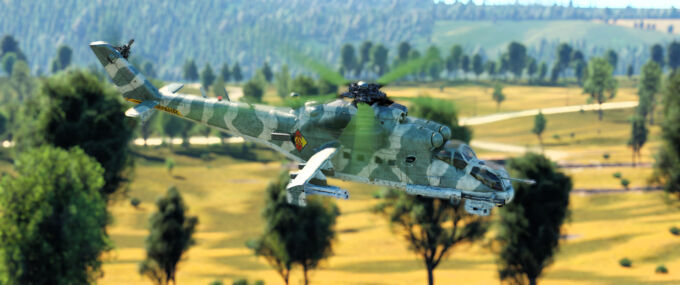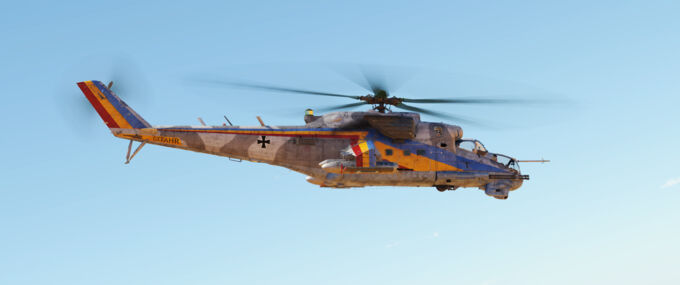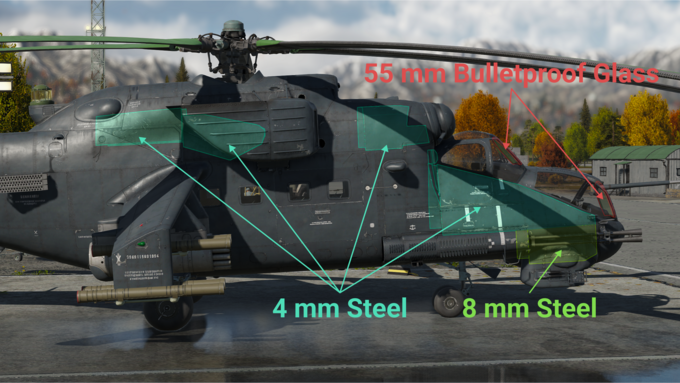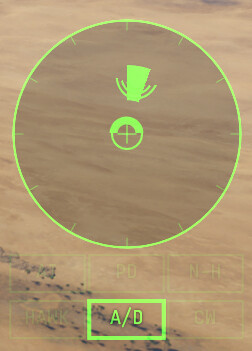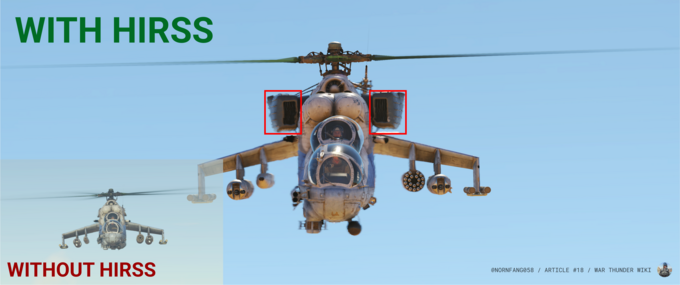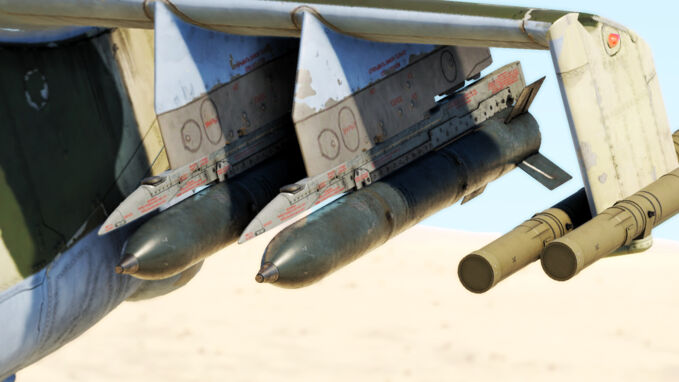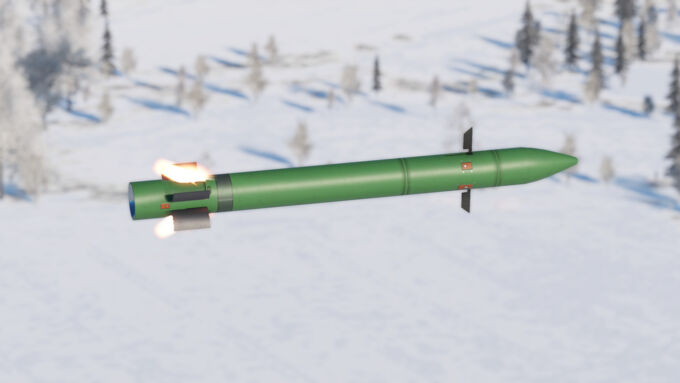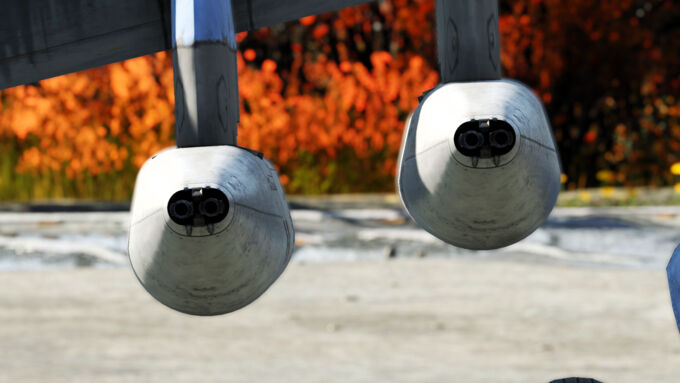The Mi-24P (NATO reporting name: Hind-F) is the dedicated anti-tank variant of the venerable Mil Mi-24V Hind attack helicopter. With its extensive suite of ground and air armaments, ranging from 500 kg bombs to the Shturm ATGM, the Mi-24P can dish out a great deal of damage while being able to tank most return fire due to its rugged construction and various survivability systems. In addition, the turreted 12.7 mm machine gun found on the preceding Mi-24V is replaced with a longer version of the Su-25's twin-barrelled 30 mm autocannon, which can easily tear apart aircraft and most ground units.
| Pros | Cons |
|---|---|
| Able to carry a large variety of armaments | Vulnerable to missiles and autocannon fire |
| Very high top speed | Poor maneuverability |
| Good survivability against most threats | 30 mm autocannon can be hard to aim |
| Gun is extremely effective against all targets | Shturm ATGMs can be difficult to guide |
The different Mi-24P variants
There are currently three variants of the Mi-24P in addition to the original Mi-24P in the USSR tech tree. There are some minor differences between them, but the most significant one is that the Hungarian Mi-24P gets a better RWR, which makes it the best Mi-24P variant in War Thunder.
Mi-24P — Germany
The German Mi-24P represents Mi-24Ps that were operated by the East German Army during the Cold War. This variant has a slightly different camouflage than the Soviet Mi-24P and uses the R-60MK air-to-air missile instead of the R-60M. Note that the R-60MK and R-60M have identical performance.
Mi-24P HFS 80 — Germany
The Mi-24P HFS 80 is a premium vehicle version of the German Mi-24P that features the unique livery of the Heeresfliegerstaffel 80 (Army Aviation Squadron 80) helicopter unit, which commemorates the Mi-24P’s retirement from the Bundeswehr.
Apart from its unique camouflage and SL/RP premium bonuses, the Mi-24P HFS 80 performs identically to its tech tree counterpart.
Mi-24P — Italy
In 1993, Hungary received a shipment of Mi-24D and Mi-24V helicopters from Germany after the Bundeswehr replaced its fleet of Hinds with the EC-665 Tiger. These Mi-24D/V helicopters were upgraded to the Mi-24P standard by Hungary, and are represented in-game as the Mi-24P (Italy). Like the Mi-24P HFS 80, the Hungarian Mi-24P is a premium vehicle and comes with SL and RP bonuses.
The Hungarian Mi-24P is the only Mi-24P to receive the upgraded SPO-15LM radar warning receiver. All other Mi-24Ps use the inferior SPO-10.
Flight characteristics
The Mi-24P does not have great maneuverability due to its heavy weight and large size, but it makes up for this with its excellent straight-line speed and climb rate.
Engines
The Mi-24P is powered by two Klimov TV3-117V turboshaft engines, with each engine outputting 220 kg/f of thrust. These are some of the most powerful engines ever installed on a helicopter, capable of propelling the Mi-24P to over 300 km/h, even when carrying a full weapon load. Pilots should be wary of going beyond 330 km/h, however, since the helicopter will gradually become less controllable.
Additionally, HIRSS modules can be installed on the engine exhausts to reduce their IR signature.
Maneuverability
The Mi-24P’s main drawback in the flight characteristics department is its lack of overall maneuverability. This is mainly caused by the Mi-24P’s heavy weight (11 tons without a weapons load) and large size, which make turning and performing evasive maneuvers difficult. Care should be taken during takeoff and low-altitude maneuvers, as the Mi-24P tends to lose lift and fall out of the air when the throttle is decreased.
Warning: The Mi-24P is prone to entering a vortex ring state, which is caused by executing maneuvers close to the ground at lower speeds. This results in a temporary loss of lift and will cause the helicopter to drop out of the air very quickly. This can be remedied by adjusting the collective pitch and pitching left to right.
Survivability
Although the Mi-24P does not have the advanced internal composite armor of more modern attack helicopters, it still has a respectable amount of steel armor, self-sealing fuel tanks, and great survivability systems to help the crew stay alive on the battlefield.
Armor
The Mi-24P features a substantial amount of internal armor, which helps to protect the crew and engines from enemy fire.
4 mm steel plates protect the pilot, gunner, and engines. Additionally, the gunner is protected from below by a series of 8 mm steel plates from the front and sides. Bulletproof glass is also integrated into the pilot and gunner’s windscreens, which decreases the occurrence of pilot snipes.
This armor is the most effective against lower-caliber machine gun rounds and high-explosive autocannon shells. The Mi-24P can easily tank 7.62 mm and 12.7 mm machine gun fire for an extended amount of time.
However, autocannon fire from dedicated SPAA or light tanks like the Gepard or 2S38 will be able to destroy the Mi-24P very quickly. Air-to-air missiles can also cripple the helicopter. Keep in mind that although the Mi-24P can shrug off a sizable amount of damage, it is not invulnerable to enemy fire.
Countermeasures
The Mi-24P is equipped with 192 regular-caliber countermeasures to defend against IR and radar missiles. There are two pods mounted on the sides of the helicopter towards the rear, with each pod containing 92 countermeasures.
Note: Countermeasures will not be effective against manually-guided (SACLOS) missiles from ground-based SPAA units.
Both flare and chaff countermeasures can be taken. Flares are for distracting IR missiles, while chaff is effective for fooling radar missiles (SARH/ARH) and to break radar locks.
RWR
The Mi-24P (USSR), Mi-24P (Germany), and the Mi-24P HFS 80 use the SPO-10 radar warning receiver, while the Hungarian Mi-24P uses the SPO-15LM.
SPO-10
The SPO-10 is a standard RWR found on many early Soviet aircraft. It is not very useful since it only provides the approximate 45-degree sector that shows where a radar emission was detected from. It can detect radar bands H–J.
SPO-15LM
The SPO-15LM can detect radar bands G–I around the helicopter and pick up radar emissions from up to 65 km away. It is also equipped with IFF, so friendly radars will not appear on the display. The SPO-15LM can display track/launch warnings for most radars and the angle of the radar emission, which is very helpful.
IRCM
All Mi-24Ps are equipped with an Infrared Countermeasure module behind the rotor assembly. The IRCM module protects the helicopter from IR-guided missiles and fools them by projecting an infrared source with a higher intensity than the helicopter’s own IR signature at the missile seeker head.
Warning: The IRCM will stop some IR missiles, but not all of them.
HIRSS
An additional Hover Infrared Suppression System (HIRSS) can be installed onto the exhaust ports to decrease the Mi-24P’s heat signature. This makes it harder for IR missiles to lock onto the Mi-24P, especially from the front.
EFS
In the event of an engine fire, the Mi-24P has an Engine Fire Suppression System (EFS) which can be used to extinguish a fire. Note that the EFS will not work for fires located in the fuel tanks.
Armaments
The Mi-24P has a wide selection of armaments that can be adjusted to suit nearly any task, whether it be base bombing or tank busting.
30 mm GSh-30-2K
The GSh-30-2K poesseses an extremely high rate of fire at a blistering 2,598 rounds per minute, so pilots will need to have good trigger discipline to avoid expending all of the ammo quickly. Use the CCIP (ballistics computer) for the gun when strafing ground targets.
| Gun belt | Belt composition | Max penetration |
|---|---|---|
| Default | HEFI-T · APHE | 47 mm |
| Universal | AP-T · HEFI-T · APHE · HEFI-T | 62 mm |
| Ground targets | AP-T · APHE · APHE | 62 mm |
| Air targets | APHE · HEFI-T · HEFI-T · HEFI-T | 47 mm |
Rockets
The Mi-24P has two types of rockets: the plentiful S-8KO and the massive S-24 that trades quantity for much more explosive filler (over 18 times more than the S-8KO). The S-8KOs are more suited for general use and rocket rushing, while the S-24s can be used against more armored targets to guarantee a kill.
When using the S-8KO rockets, attacking from above is the best method to secure quicker kills since the rockets can overpressure the target more easily.
Air-to-ground missiles
The 9M114 Shturm air-to-ground missile (ATGM) is the Mi-24P’s primary weapon for long-range engagements against ground targets. The Shturm has good maneuverability and travels quickly, but its effectiveness is nullified by ERA or composite armor. Additionally, the Shturm is SACLOS guided, so pilots will manually have to guide the missile to the target using their mouse or joystick.
The Shturm has a max range of 5 kilometers, so the Mi-24P will be able to combat most gun-armed SPAA safely from a distance. However, be aware of proxy rounds, which can still maintain their lethality over a long distance (e.g., from the M247 or 2S38).
| Guidance | Projectile mass | Max range | Flight speed | Penetration | Explosive mass (TNTe) |
|---|---|---|---|---|---|
| SACLOS | 31.4 kg | 5 km | 550 m/s | 560 mm | 4 kg |
Air-to-air missiles
For defence against airborne threats, the Mi-24P can use the R-60 and R-60M infrared missiles. These missiles lack flare resistance and range, but are useful for downing enemy aircraft that are not paying attention or that do not have flares.
Note: German variants of the Mi-24P use the export R-60MK instead of the R-60M. Both the R-60MK and R-60M perform identically.
Avoid using the R-60 and load the R-60M instead, since the R-60M has all-aspect capability while the R-60 is limited to a rear or side aspect lock. Additionally, dual racks for the R-60/R-60M allow two missiles to be carried on one pylon.
Unguided bombs
One of the more unusual armaments on the Mi-24P are its OFAB-250sv and FAB-500M-54 dumb bombs. These are the most effective for Helicopter PvE or Ground Assault, since their limited range forces the Mi-24P to be extremely close to enemies.
Warning: Make sure to set a bomb fuze! The concussion and blast damage from bombs can easily destroy critical components in the helicopter.
| Bomb | Weight | Explosive mass (TNTe) |
|---|---|---|
| 250 kg OFAB-250sv | 250 kg | 97 kg |
| 500 kg FAB-500M-54 | 478 kg | 201 kg |
Gunpods
The Mi-24P has access to the GSh-23L and GShG-7.62/YaK-B gunpods to supplement its firepower. Due to the mediocre penetration of both gunpods, these are more suited for downing aircraft than for engaging ground targets.
Did you know? The GShG-7.62/YaK-B gunpod is a combination of two 7.62 mm GShG machine guns and a single 12.7 mm YaK-B machine gun. This gunpod has an extremely high rate of fire due to the rotary design of all machine guns.
Usage in battles
There are two general ways to play the Mi-24P in ground battles: rocket rushing or using the Shturms ATGMs to snipe targets from a distance.
Rocket rushing
Recommended loadout: 80x S-8KO rockets
A useful way to earn easy kills at the beginning of the match is by spawning in the Mi-24P with a full rocket load and then quickly striking enemies with the rockets and cannon up close.
Players should keep in mind that rocket rushing is typically a one-way trip, since the helicopter will usually be crippled or outright destroyed by combined enemy fire, so don’t be afraid to expend all the available ammo quickly.
Note: Vehicles that have rapid-firing autocannons will be the greatest threat when rocket rushing. However, keep in mind that getting hit by a round from an MBT is also fatal.
When rocket rushing, approaching from the sides or back is always recommended to reduce the helicopter’s exposure to enemy fire. Quickly strike targets, and keep moving. Never hover or stay in one place too long, since enemies will be able to spot and target the vehicle faster.
ATGM slinging
Recommended loadout: 8x 9M114 Shturm ATGM, 40x S-8KO rockets
The Mi-24P also performs fairly well in longer-range engagements while using its Shturm ATGMs. A pylon of Shturm ATGMs can also be replaced with a double rack of R-60Ms to give the Mi-24P a degree of anti-aircraft capability.
Prioritize anti-air vehicles first before focusing on MBTs or other targets. The max range of the Shturm ATGM is 5 km, so maintain a 4.0 — 4.5 km distance from the enemy spawns. The RWR can be used as a source to see whether enemy anti-air is spawned in. The SPO-15LM on the Hungarian Mi-24P excels at this, since it can provide the radar type, launch warnings, and the near-exact angle of the radar source.
When guiding the Shturms, keep a steady hand and avoid making sudden corrections to the flight path. The missile will become less responsive and harder to control over distance, and overcorrections can cause the missile to sway violently.
And as always, pay attention to whether enemy aircraft are around. A distracted Mi-24P is an easy target for nearly all enemy jets.

